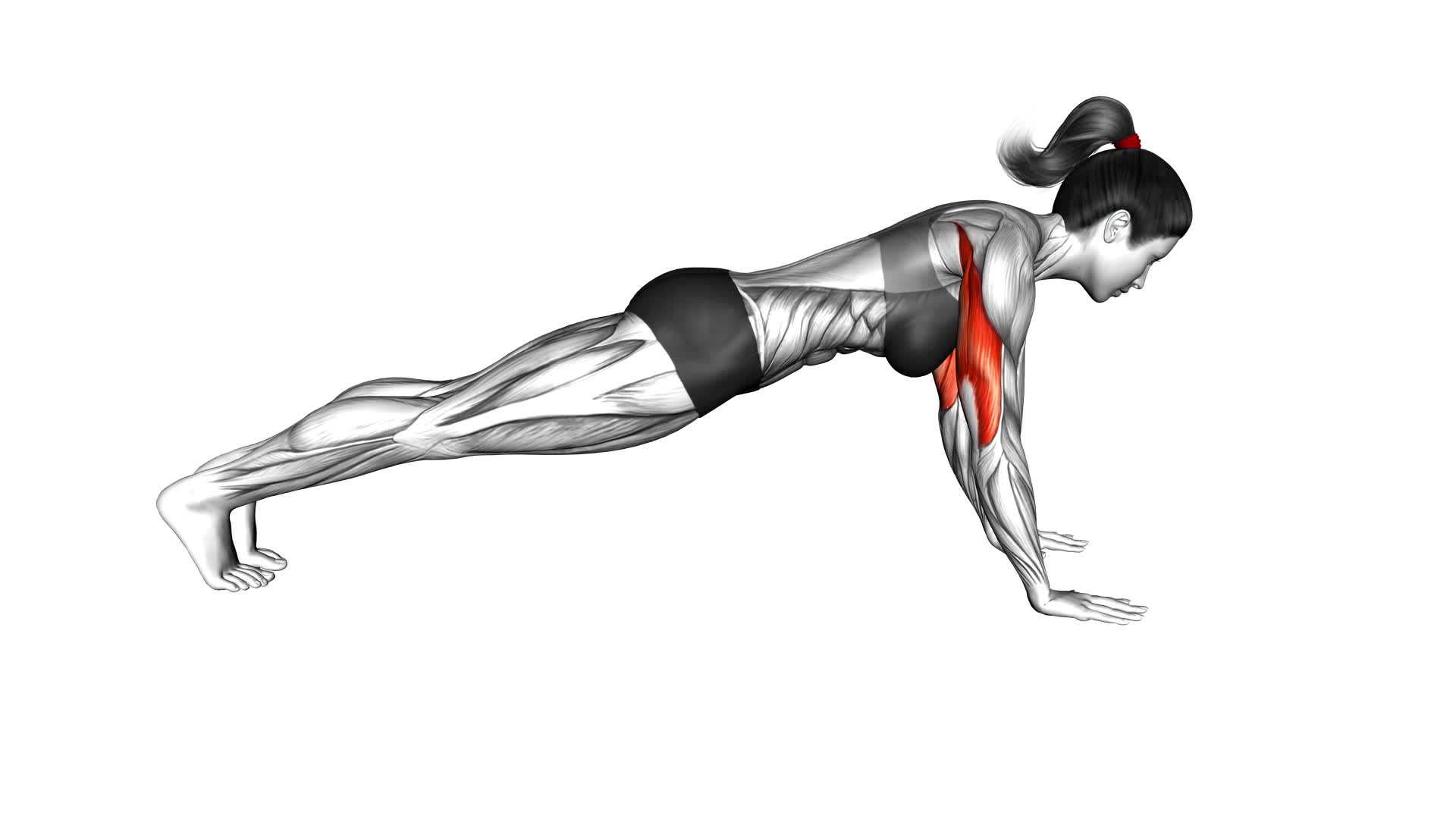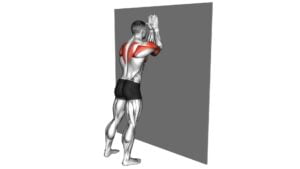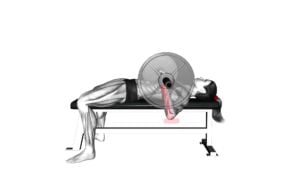Push-up on Forearms (female) – Video Exercise Guide & Tips

Get ready to strengthen your upper body with the push-up on forearms.
Watch This Exercise Video
This video exercise guide and tips will help you master this challenging move.
Learn the benefits, proper form, and modifications for beginners.
If you're more advanced, we've got variations to push your limits.
Follow these tips to maximize your results and achieve a stronger, more toned physique.
Let's dive in and conquer the push-up on forearms!
Key Takeaways
- The push-up on forearms improves core strength and targets abdominal muscles, lower back, and hips.
- Proper form and technique include positioning forearms flat on the floor with elbows beneath shoulders, keeping legs extended and toes on the ground, and maintaining a straight line from head to heels.
- Modifications for beginners include performing push-ups on knees, using an elevated surface for added stability, and gradually increasing difficulty to progress towards full exercise.
- Advanced variations such as the Spiderman push-up on forearms and single-leg push-up on forearms can challenge balance, strengthen core, and intensify the workout.
Benefits of the Push-up on Forearms
To maximize your workout, it's important to understand the benefits of performing push-ups on your forearms. By doing push-ups on your forearms, you can greatly improve your core strength and increase shoulder stability.
One of the main benefits of performing push-ups on your forearms is the improvement in core strength. When you perform a push-up on your forearms, you engage your core muscles to maintain stability and control throughout the movement. This not only strengthens your abdominal muscles but also targets the muscles in your lower back and hips. As a result, you develop a stronger and more stable core, which is essential for maintaining proper posture and balance.
Additionally, performing push-ups on your forearms helps to increase shoulder stability. When you place your weight on your forearms instead of your hands, you activate the muscles in your shoulders and upper back to a greater extent. This helps to strengthen the muscles that support and stabilize your shoulder joints, reducing the risk of injury and improving overall shoulder function.
Proper Form and Technique
Mastering the proper form and technique for the push-up on forearms is essential for effectively engaging your core and shoulder muscles. To ensure you're performing this exercise correctly and minimizing the risk of common mistakes or injuries, follow these guidelines.
First, start by positioning yourself on the ground with your forearms flat on the floor and your elbows directly beneath your shoulders. Your legs should be extended behind you, with your toes on the ground. Engage your core and maintain a straight line from your head to your heels throughout the exercise.
Next, lower your body by bending your elbows, keeping them close to your sides. Avoid letting your hips sag or your lower back arch. Aim to lower yourself until your elbows are at a 90-degree angle.
Once you reach the bottom position, push through your forearms to extend your arms and return to the starting position. Remember to breathe steadily throughout the movement.
Common mistakes to watch out for include allowing your elbows to flare out to the sides, which can put unnecessary strain on your shoulders. Additionally, avoid letting your hips drop or your back sag, as this can lead to lower back pain.
Modifications for Beginners
If you're just starting out with the push-up on forearms, here are some modifications to help you build strength and gradually work your way up to the full exercise.
As a beginner, it's important to start with exercises that are suitable for your fitness level to prevent injury and ensure proper form.
One common mistake beginners make is trying to perform the push-up on forearms without enough upper body strength. To modify the exercise, begin by performing the push-up on your knees instead of your toes. This reduces the amount of weight you need to lift and allows you to focus on building strength in your arms and core.
Another modification is to perform the push-up on an elevated surface, such as a bench or step. This reduces the amount of weight you need to lift and provides additional stability. Start by placing your hands on the elevated surface and keeping your body in a straight line. Lower yourself towards the surface, keeping your elbows close to your body, and then push back up.
Remember to engage your core and keep your body in a straight line throughout the exercise. By gradually increasing the difficulty of the push-up on forearms, you'll build strength and eventually be able to perform the full exercise with proper form.
Advanced Variations to Challenge Yourself
Challenge yourself and take your push-up on forearms to the next level with these advanced variations.
If you're looking to intensify your workout and challenge your muscles even further, these advanced modifications will help you achieve that.
One of the advanced variations is the Spiderman push-up on forearms. To perform this exercise, start in a push-up position on your forearms. As you lower your body towards the ground, bring your right knee towards your right elbow, then return to the starting position. Repeat on the left side. This variation targets your core and obliques while also working your upper body.
Another advanced modification is the single-leg push-up on forearms. Start in a push-up position on your forearms and lift one leg off the ground. As you lower your body towards the ground, keep your leg lifted and engage your core for stability. This variation challenges your balance and strengthens your core.
When attempting these advanced variations, it's important to avoid common mistakes such as sagging your hips or letting your elbows flare out. Maintain proper form and engage your core throughout the exercise to maximize its benefits.
Keep pushing yourself and enjoy the challenge of these advanced variations.
Tips for Maximizing Your Results
To get the most out of your push-up on forearms exercise, consistently incorporate these tips into your routine.
First and foremost, it's important to avoid common mistakes that can hinder your progress. One common mistake is allowing your hips to sag or your back to arch during the exercise. This not only reduces the effectiveness of the exercise but also puts unnecessary strain on your lower back. To avoid this, engage your core muscles and keep your body in a straight line from your head to your heels.
Another common mistake is rushing through the exercise and sacrificing proper form. It's crucial to maintain good form throughout each repetition to target the correct muscles and prevent injury. Take your time and focus on executing each movement with control and precision.
In terms of recommended sets and reps, aim for three sets of 10 to 12 repetitions. This will provide a good balance between building strength and muscular endurance. As you become more comfortable with the exercise, you can gradually increase the number of sets or reps to continue challenging yourself.
Frequently Asked Questions
How Many Calories Can I Expect to Burn by Doing Push-Ups on Forearms?
By doing push-ups on your forearms, you can expect to burn calories and aid in weight loss. The number of calories burned will vary depending on factors such as your weight, intensity, and duration of the exercise. Push-ups engage multiple muscles in your body, making it an effective calorie-burning exercise. To maximize the calorie burn, maintain proper form and gradually increase the intensity of your workouts over time.
Remember to consult with a fitness professional for personalized advice.
Can Push-Ups on Forearms Help Reduce Belly Fat?
Push-ups on forearms can be a great exercise to target your core muscles, including the abs. They engage multiple muscle groups, helping to burn calories and reduce overall body fat, including belly fat.
However, it's important to note that no exercise specifically targets fat loss in one area. To maximize the benefits, combine push-ups on forearms with other core exercises and maintain proper form.
Consult a fitness professional for guidance on proper form.
How Long Does It Take to See Results From Doing Push-Ups on Forearms?
When it comes to seeing results from doing push-ups on forearms, it depends on various factors. Commitment to a regular exercise routine, proper form, and consistency are key.
Push-ups on forearms can help strengthen your core, arms, and chest muscles. With time and effort, you may start noticing improvements in muscle tone and strength.
Remember to maintain proper form, engage your core, and gradually increase the intensity to maximize the benefits of push-ups on forearms.
Are Push-Ups on Forearms Suitable for People With Wrist Injuries?
Push-ups on forearms can be a suitable alternative for people with wrist injuries. These exercises provide similar benefits for upper body strength without putting excessive pressure on the wrists. By performing push-ups on forearms, you can still target your chest, shoulders, and triceps effectively. They help in building upper body strength, improving posture, and enhancing core stability.
However, it's essential to consult with a healthcare professional or a certified trainer to ensure these exercises are appropriate for your specific condition.
Can Push-Ups on Forearms Improve Posture?
Push-ups on forearms can improve your posture by strengthening your core muscles and improving balance. By engaging your abdominal muscles, back muscles, and shoulder muscles, you can develop better posture and alignment throughout your body.
This exercise targets the muscles that support your spine, helping you maintain a more upright position. Incorporating push-ups on forearms into your workout routine can lead to improved posture and overall body strength.
Conclusion
In conclusion, the push-up on forearms is a highly effective exercise for strengthening the upper body, particularly the arms, shoulders, and core muscles. By maintaining proper form and technique, individuals can maximize their results and avoid injuries.
Beginners can modify the exercise to suit their fitness level, while advanced variations provide a challenge for those seeking to push their limits.
Incorporating this exercise into your routine can help you achieve your fitness goals.

Author
Years ago, the spark of my life’s passion ignited in my mind the moment I stepped into the local gym for the first time. The inaugural bead of perspiration, the initial endeavor, the very first surge of endorphins, and a sense of pride that washed over me post-workout marked the beginning of my deep-seated interest in strength sports, fitness, and sports nutrition. This very curiosity blossomed rapidly into a profound fascination, propelling me to earn a Master’s degree in Physical Education from the Academy of Physical Education in Krakow, followed by a Sports Manager diploma from the Jagiellonian University. My journey of growth led me to gain more specialized qualifications, such as being a certified personal trainer with a focus on sports dietetics, a lifeguard, and an instructor for wellness and corrective gymnastics. Theoretical knowledge paired seamlessly with practical experience, reinforcing my belief that the transformation of individuals under my guidance was also a reflection of my personal growth. This belief holds true even today. Each day, I strive to push the boundaries and explore new realms. These realms gently elevate me to greater heights. The unique combination of passion for my field and the continuous quest for growth fuels my drive to break new ground.



